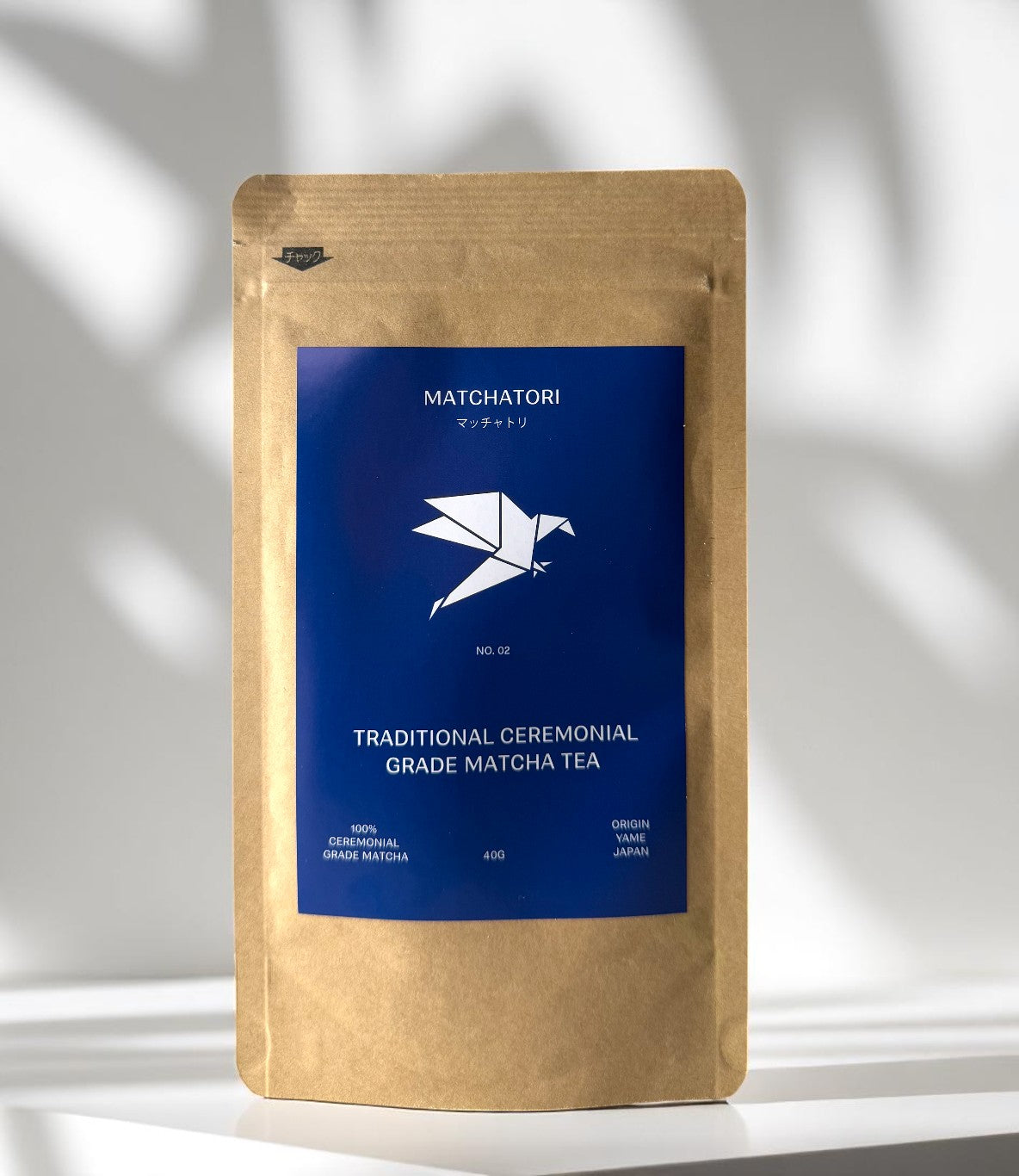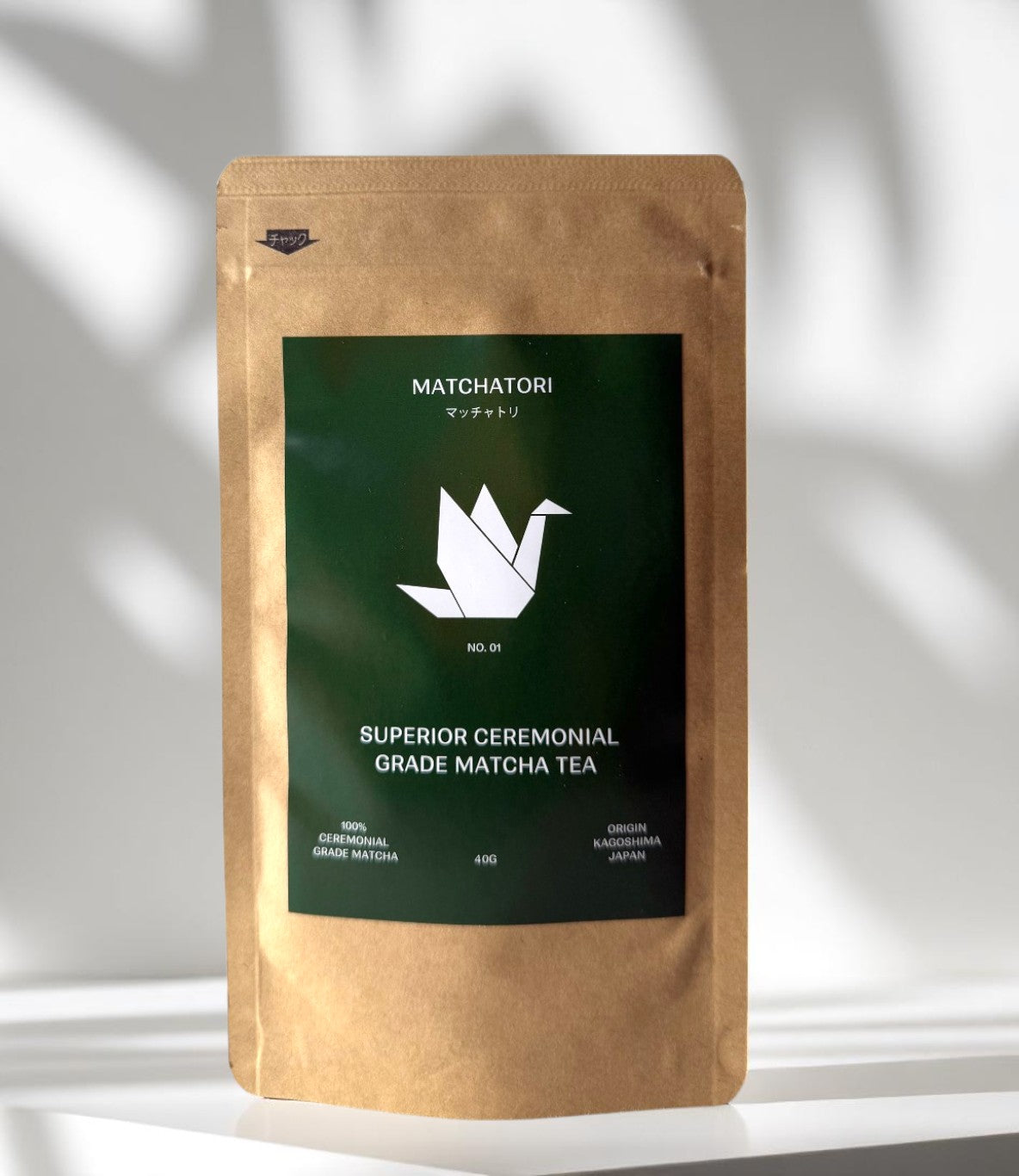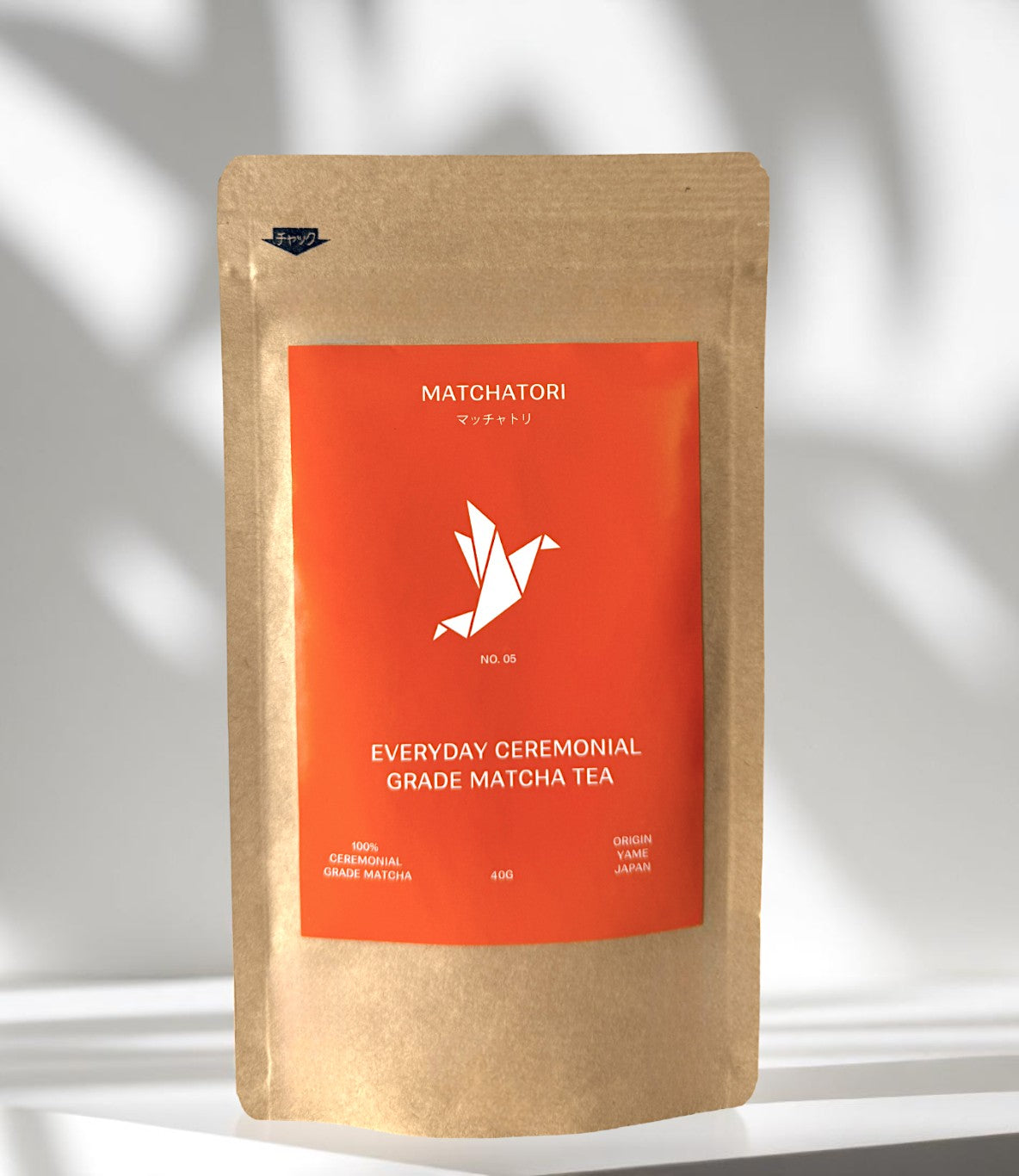Have you ever ordered a matcha latte and wondered, “what does matcha taste like?” — earthy or sweet, grassy or creamy? With UK café sales of matcha doubling in 2025 and more than 1,000 shops now serving it, curiosity about what is matcha and its unique flavour is booming.
Unlike regular green tea, matcha tea lets you drink the entire leaf — a concentrated burst of umami, antioxidants, and natural sweetness. Yet, the true taste of matcha changes with grade, temperature, and whisking technique.
This guide unpacks what is matcha made of, how it’s crafted, and why each sip tells a different story of Japan’s green elixir.
Key Takeaways
-
Matcha delivers a complex taste of matcha—sweet, umami, grassy, and delicately bitter.
-
Both grade and water temperature dictate the flavor matcha you’ll experience.
-
70–75 °C creates a smooth, creamy sweetness; hotter water highlights vegetal boldness.
-
The UK’s matcha market grew 120% in 2025, generating over £7 million in two months (Financial Times), showing its booming café appeal.
-
Ceremonial grades bring harmony; latte grades offer a robust, creamy matcha flavour for milk lovers.
-
Mastery lies in balance—whisking, temperature, and grade selection.
Understanding Matcha — Meaning, Origin, and What’s Inside It
What Is Matcha Made Of? The Heart of Japanese Green Tea
If you’ve wondered what is matcha made from, it starts with tencha, a premium tea leaf grown in shade for up to 30 days. This process boosts chlorophyll, intensifying its vivid green color and deep matcha flavour.
The leaves are then stone-ground into a fine powder—this is what is matcha green tea made of. Because you consume the entire leaf, what is inside matcha includes caffeine, antioxidants, and amino acids like L-theanine, responsible for that calm, focused energy.
This is why matcha stands apart from all other types of matcha tea—it’s both concentrated and balanced.
Definition of Matcha — Beyond a Trendy Latte
Matcha meaning extends far beyond the cup—it embodies Zen mindfulness and Japanese craftsmanship. It’s the soul of chanoyu, the traditional Japanese tea ceremony.
But today, you’ll find matcha latte in cafés worldwide, merging heritage with modern flavor trends. Those asking “what does a matcha latte taste like?” discover a creamy, mellow, sweet taste that contrasts beautifully with coffee’s bitterness.
To experience authenticity, try the Traditional Ceremonial Grade Matcha 40 g—a reflection of Japan’s timeless tea artistry.

In Image: No 2. Traditional Ceremonial Grade Matcha 40 g
What Does Matcha Taste Like? Let’s Decode the Flavor
The Core Taste Profile — Earthy, Umami, Sweet, and Bitter in Harmony
High-grade matcha flavor blends grassy freshness with silky sweetness and a lingering umami finish. As L-theanine balances the bitter catechins, you get a creamy, almost marine-like richness.
Proper whisking aerates the tea, softening astringency and enhancing foam. The result? A smooth, full-bodied drink that many describe as the “green espresso of Japan.”
What Does Matcha Taste Like by Grade? A Flavor Map
Superior & Signature Ceremonial Grade Matcha — Smooth Umami & Sweet Elegance
At the top tier, Superior Ceremonial Grade Matcha 40 g and Signature Ceremonial Grade Matcha 40 g deliver velvety texture, vivid color, and subtle natural sweetness.
They’re known for low bitterness, rich umami, and lingering sweetness. Experts liken the mouthfeel to melted cream with hints of seaweed and almond. Ideal for pure sipping—best enjoyed whisked with 70 °C water.

In Image: No 1. Superior Ceremonial Grade Matcha 40 g
Traditional Ceremonial Grade Matcha — Balanced Depth and Aroma
Balanced and aromatic, this matcha tea flavor harmonizes sweetness and gentle vegetal tones. It’s the bridge between luxury and everyday enjoyment.
Smooth yet expressive, this grade suits both ceremonial bowls and modern tea rituals. It captures what many describe as “true matcha taste”—mellow, rounded, slightly nutty.
Everyday Ceremonial Grade Matcha — The All-Rounder for Daily Rituals
The Everyday Ceremonial Grade Matcha 40 g brings daily consistency with slightly bolder grassy tones. Still smooth enough for pure tea, it also shines in smoothies or baking.
Ideal for those who love matcha taste that’s not too delicate, not too strong. A balanced entry into the world of authentic Japanese tea.

In Image: No 5. Everyday Ceremonial Grade Matcha 40g
Latte Grade Matcha — Creamy, Bold, and Perfect for Milk Lovers
For fans of matcha latte, this grade cuts through milk with its robust green tone. Latte Grade Matcha 40 g delivers creamy sweetness, mild bitterness, and a toasty, comforting aroma.
Its texture and taste mirror what matcha coffee enthusiasts adore—a gentle energy without the jitters. Perfect for both iced and hot drinks, it’s the matcha made for café creativity.

In Image: No 3. Latte Grade Matcha 40 g
How Water Temperature Shapes Matcha Flavor (Hot vs Cold Matcha Taste)
Matcha Taste at Different Water Temperatures
The matcha water temperature directly shapes flavor extraction.At 70 °C, amino acids dominate—sweet and smooth.At 80 °C, the matcha flavour deepens with vegetal tones.
At 85–90 °C, catechins rise, giving a bolder, slightly bitter edge. (PMC Study on Catechins)
Perfect Brewing Guide for Balanced Matcha Taste
Whisking is key: sift, measure, pour, and froth. Use 70–75 °C for sweeter, creamier tea, or slightly hotter water for stronger vegetal flavor. Your Matcha Whisk ensures micro-foam and soft mouthfeel. As experts note, “the whisk defines the texture; the water defines the taste.”
Matcha Iced or Hot — How It Changes the Flavor Map
Hot matcha is richer and more aromatic, emphasizing depth and umami. Cold matcha feels lighter and sweeter—ideal for summer. Cold-brewed versions retain delicate florals and fresh melon-like undertones. Try pairing with Deeply Roasted Hojicha Tea for a yin–yang of roasted and green notes.
What Influences the Flavor of Matcha? From Soil to Storage
Matcha Growing Conditions and Shading Techniques
Where is matcha from? Predominantly Uji, Nishio, and Kagoshima in Japan. Shade-growing enhances L-theanine and chlorophyll, giving matcha tea its sweet, umami-forward flavor.
This shading process limits sunlight by 70–90%, slowing growth but intensifying taste. At Matchatori, our tea masters preserve this tradition for maximum matcha flavour integrity.
How Processing Impacts the Matcha Flavoring
Slow stone grinding under cool conditions protects aroma and freshness.Fast milling causes oxidation, resulting in dull flavor and faded color. That’s why Matchatori’s perfected matcha powder is milled in micro-batches to maintain vibrancy.
Each step is crafted for consistency—because how is matcha made defines how does matcha taste.
Storing Matcha the Right Way to Preserve Its Taste
Light, heat, and oxygen are flavor’s worst enemies. Keep matcha sealed airtight, refrigerated, and dry for freshness. Open containers should be consumed within 60 days for peak matcha flavouring. Proper storage ensures your matcha stays bright, sweet, and aromatic—just as intended.
Comparing Matcha Flavors — What Does Matcha Taste Most Similar To?
Matcha vs Green Tea
Many ask if matcha taste like tea—yes, but more intense. Regular green tea is lighter, while matcha feels fuller because you consume the whole leaf.
The taste of matcha combines the grassy aroma of sencha with the creaminess of steamed spinach and seaweed. It’s like tasting the “essence” of green tea amplified tenfold.
Matcha vs Coffee
Compared to matcha coffee, traditional coffee is roasted, acidic, and bitter-forward. Matcha is naturally smoother, offering sustained focus thanks to L-theanine.
It gives “calm alertness” without caffeine spikes—ideal for mindful energy. No wonder matcha is replacing espresso shots in wellness cafés worldwide.
Matcha vs Hojicha
Hojicha is roasted green tea with a warm, nutty aroma—almost caramel-like. Matcha, by contrast, is bright, vegetal, and savory. Pairing both creates a contrast between roasted and fresh—perfect for palate exploration.
The Deeply Roasted Hojicha Tea offers a cozy, aromatic counterpoint to matcha’s vivid greenness.
FAQs — Your Matcha Taste Questions Answered
Q. What temperature should water be for matcha?
A. Ideal brewing temperature is 70–75 °C. Cooler water enhances sweetness and umami, while boiling water extracts bitterness.
Q. Is grade AAA matcha good?
A. “AAA” isn’t a regulated grade—it’s marketing shorthand. Focus on origin, color, and freshness instead. Ceremonial or superior matcha grades ensure true flavor and aroma.
Q. How do I know what grade my matcha is?
A. Look for vibrant green color, fine texture, and minimal bitterness. Ceremonial grades feel creamy and smooth; culinary grades are coarser and more bitter.
Q. Does matcha taste different hot or cold?
A. Yes. Hot matcha is rich and savory; cold matcha is lighter and more refreshing. Cold brews preserve amino acids and highlight sweetness.
Q. Is matcha healthy to drink daily?
A. Absolutely—in moderation. Its antioxidants, chlorophyll, and L-theanine support focus and detoxification. Two cups a day is a balanced intake.
Q. Is matcha healthier than coffee?
A. Both have benefits. Matcha provides steady energy and antioxidants without caffeine crashes. Coffee offers alertness but may cause acidity or jitters for some.
Q. What does matcha taste most similar to?
A. It tastes like a mix of steamed spinach, sweet peas, and umami broth—grassy, creamy, and subtly sweet. That’s the unique matcha flavour no other tea matches.
Conclusion — Savoring the True Flavor of Matcha
The taste of matcha is an evolving balance of grade, temperature, and technique. Cooler water unlocks sweetness; higher heat brings grassy vigor. Whisking transforms texture into smooth velvet.
To begin your journey, try Signature Ceremonial Grade Matcha 40 g from Matchatori —crafted for balance, clarity, and pure matcha flavor profile. Explore. Experiment. Enjoy the ritual that turns green powder into peace in a cup.

